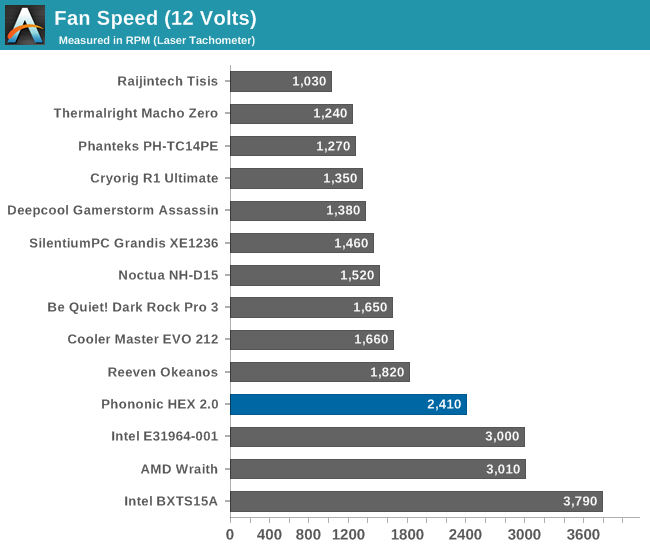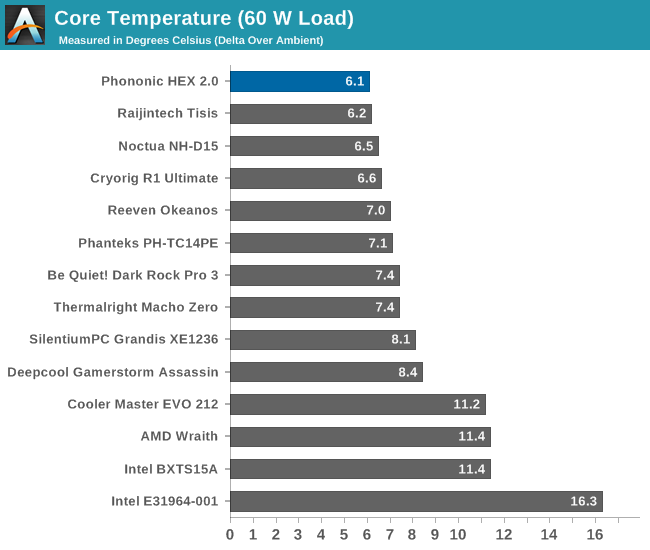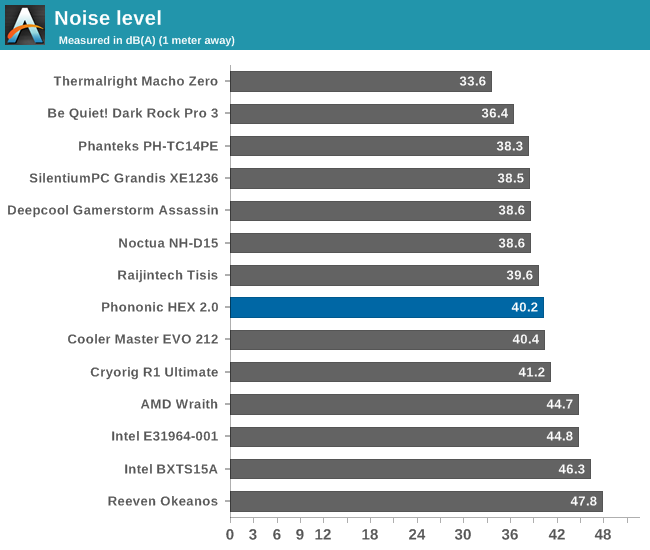The Phononic HEX 2.0 TEC CPU Cooler Review
by E. Fylladitakis on September 26, 2016 9:30 AM EST- Posted in
- Cases/Cooling/PSUs
- Cooler
- TEC
- Phononic
- HEX 2.0
Testing results, maximum fan speed (12 Volts)
The thermal performance of the Phononic HEX 2.0 is a relatively complicated topic. Most typical coolers have a relatively steady absolute thermal resistance regardless of the load or, depending on the cooler’s mass, the absolute thermal resistance slightly decreases as the temperature difference increases. The HEX 2.0 shows the completely opposite behavior; it’s absolute thermal resistance is very high at lower loads but it sharply degrades at higher loads. This happens because, in layman’s terms, the TEC cannot cope with the excessive thermal energy while, at the same time, it inserts its own thermal losses into the system, leaving the relatively small tower cooler to cope with much more than just the chip it is supposed to be cooling.


| Core Temperature, Constant Thermal Load (Max Fan Speed) |
The average thermal resistance of the HEX 2.0 is 0.1459 °C/W, which seems to be poor considering the target audience of this cooler. However, the thermal resistance of the cooler with a low thermal load of 60W is 0.1017 °C/W, easily rivaling the largest of tower coolers and even liquid cooling solutions. As the load increases, the thermal resistance of the HEX 2.0 decreases, particularly with thermal loads above 200W. With a thermal load of 340W, the thermal resistance of the HEX 2.0 drops down to 0.1685 °C/W, hardly competing with the performance of budget-oriented and stock coolers.

As for the energy consumption, the HEX 2.0 will almost entirely disable the TEC for thermal loads below 20W to minimize consumption and will prevent condensation issues. It will not push the chip to temperatures below the ambient in its balanced mode. If set to the insane mode, the TEC will always operate at maximum mode and could possibly get the CPU to register temperatures below the ambient, but only if the thermal load is very low.

Aside from it turning the TEC off completely, the TEC controller virtually has two operation modes; half power and full power. The controller decides when to set each mode depending on the thermal load and the ambient temperature. Roughly, the TEC shuts down for a thermal load below 15W, it operates at half-power mode for a thermal load between 15W and 90W, and goes at full-power mode for a thermal load above 90W. The TEC itself consumes about 20W at half power mode and 40W at full power mode, with the exact value slightly varying depending on the temperature. Note that a large percentage of this energy consumption is inserted as additional thermal load for the cooler to dissipate.










48 Comments
View All Comments
Communism - Monday, September 26, 2016 - link
The best way to do long term below ambient CPU or GPU cooling is to attach a mini-split (google it if you don't know what the term means) to a water cooling loop attached with a copper to copper [imagine something similar to interface between the IHS and the contact plate of a cooler] connection (To interface the mini-split to the water cooling loop without any fuss).This will simultaneously cool your CPU/GPU below ambient for extended periods of time while piping the heat directly outside your home.
hybrid2d4x4 - Monday, September 26, 2016 - link
This is more of a comment on your testing platform than this review, but it seems to me that your current setup has a few shortcomings.1) The testing platform isn't close enough to simulating the sockets of mobos to give any meaningful comment on how good the mounting mechanism is on the cooler. This is especially true of AMD socket.
2) The operating range for your thermal load isn't well suited to represent CPUs. IMO, it would be infinitely more useful to have something that ranges from 5-10W (~the idle state of a modern CPU if not less) to 100W (or whatever actual power draw an enthusiast OC setup would be). While interesting in an academic sense, testing up to 340W is completely irrelevant and beyond the design targets that these coolers were aiming for.
BurntMyBacon - Monday, September 26, 2016 - link
AMD FX-9000 series processors are rated for 220W. Processors consume more power at an exponential rate as more voltage is applied. Perhaps 340W is a bit much, but not as far off as you seem to think.That said, I would like to put in another vote for representing more lower power gradients. Common TDPs are something like 5W, 15W, 25W, 45W, 65W, 95W, 125W, and 140W. Higher TDPs like 180W and 220W are also present, though less common. You don't need to hit all of these TDPs, but just 60W probably isn't a good representation for everything under 100W.
DanNeely - Monday, September 26, 2016 - link
The crazy high TDPs are also reachable with aggressive overclocking and high end cooling.Sushisamurai - Monday, September 26, 2016 - link
I too second this opinion. I would like to see more temp gradients around the 60, 80, 100, 120, 140W of usage... A graph for these things would be nice if time was permitted, as when the author mentions thermal resistance/performance falling off, he's not very specific at what point does it "fall off" (eg: is it competitive at 60-100 but falls off at >120?). I imagine a lot of people use this site's data and opinions to shop for products, and having more gradients to align with purchase decisions would be nice. I know I have a 80W stock load, 120W Oc, 140W stock and 220-240W loads. Extrapolating your data is doable, but I think not everyone can. My re-verification numbers on my home hardware #'s are similar to the extrapolations and your test results, so I thank you.eldakka - Tuesday, September 27, 2016 - link
I'd also like to see lower TDP measurements. I'm not thinking of overclocking situations, but more HTPC-type situations, where with a good, quiet cooler you might be able to put a more powerful processor in the HTPC while still remaining quiet.This thing being chromed might look pretty cool in a HTPC sitting under a telly...a slimline case with a hole cut in the top for so the fins stick out the top, like a blower sticking out of the bonnet (hood) of a car ;)
hybrid2d4x4 - Tuesday, September 27, 2016 - link
Wow, thanks for that eye opener! I assumed the most power-hungry CPU you can buy today that's not AMD from a few gens ago was 95W. 220W! What a beast...Vayra - Monday, September 26, 2016 - link
Well, I for one am completely uninterested in idle temps, because given a large enough heatsink you can likely even passively cool that.It is much more interesting and informative to have 'over the top' TDPs rather than a slew of low TDPs because that is when cooling starts to struggle. For any non-OC'd CPU, you can suffice with the regular boxed cooler and it will keep it safe from throttling 99% of the time, or at least close enough to not matter at all.
Typical mid range consumer TDP is 65w up to 95w for a quad core. So the 60w and 100w very clearly represent the majority of use cases and non-OC situations. Lower TDP is irrelevant - all coolers will perform as good, or better, at lower TDP - this enters the region of 'who cares' because there are literally zero benefits to running very low temp at low. Temperatures matter when they pass the 50-60 C barrier because they then *might* start influencing current leakage. Below that temperature, it's basically a non issue on all counts.
DanNeely - Tuesday, September 27, 2016 - link
While its true that all large coolers will do well at <60W, low wattage desktop CPUs (eg Intel's 35W series) are often used in slimline mITX cases where even something like Intel's stock cooler is too large to fit. Temperature/noise tradeoffs there become an important consideration again; as do idle core temperatures. That would be a different set of testing ranges than the one that E. Fylladitakis currently runs; and more inline with what Silent PC Review authors test.Vayra - Monday, September 26, 2016 - link
Well, I for one am completely uninterested in idle temps, because given a large enough heatsink you can likely even passively cool that.It is much more interesting and informative to have 'over the top' TDPs rather than a slew of low TDPs because that is when cooling starts to struggle. For any non-OC'd CPU, you can suffice with the regular boxed cooler and it will keep it safe from throttling 99% of the time, or at least close enough to not matter at all.
Typical mid range consumer TDP is 65w up to 95w for a quad core. So the 60w and 100w very clearly represent the majority of use cases and non-OC situations. Lower TDP is irrelevant - all coolers will perform as good, or better, at lower TDP - this enters the region of 'who cares' because there are literally zero benefits to running very low temp at low. Temperatures matter when they pass the 50-60 C barrier because they then *might* start influencing current leakage. Below that temperature, it's basically a non issue on all counts.